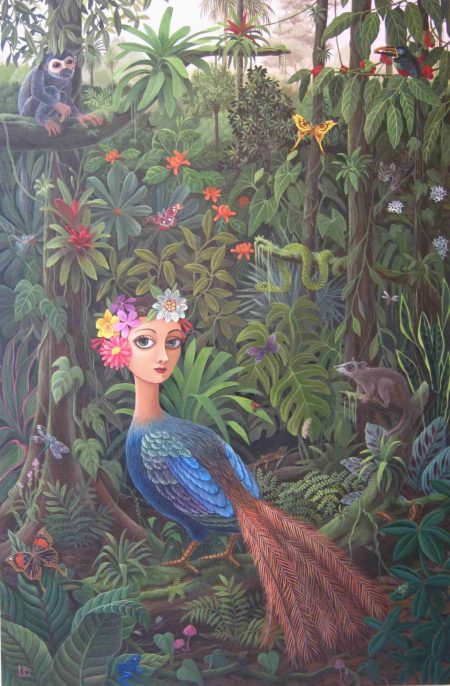
Mounting the stairs at the YWCA Women’s Art Gallery to see “Other Wordly,” the word that came to mind was “charming” as I encountered the paintings of one of three artists in the exhibition: Laine Bachman. Her hyper-realistic paintings have a fairytale quality, enchanting and entrancing.
In her In the Undergrowth, (2011, acrylic on canvas, 46” x 30”), the head of a big-eyed beauty with flowers in her hair is grafted onto the body of a peacock, but his/her tail feathers look more like browned cedar needles than the glorious plumes we expect. In many, many cultures there are gods that are part human, part bird, but Bachman’s hybrid is from her imagination. She explains:
My artwork is a blend of whimsical themes and decorative motifs. The themes are often inspired by myths and folklore, beliefs and misconceptions. I infuse these different ideas with archetypal images to create a deeper story within the world I create.1
With a come-hither look, Bachman’s creature perches on a branch in a glorious jungle of exotic blooms that you can almost smell and which teems with animals. A curious rat sniffs at the bird woman; a monkey sits on a branch above pondering whether to launch himself at her; and a snake, coiled around a branch, slithers toward her. Hovering around her are butterflies, which represent transformation to Bachman. Their wings are punctuated by “eyes,” making them look like fanciful masks. There is a zoo-load of other animals including a toad, lizard, ocelot, toucan, and various insects. Her paint handling is delicate, meticulous, and obsessive, as can be seen in videos of her working (See YouTube.com).
Bachman’s big-eyed women recall Margaret Keane’s waifs; the flattened picture plane is like an Henri Rousseau painting; and her fantastic landscape with its menagerie naturally evokes The Peaceable Kingdom by Edward Hicks. Bachman takes these traits, knowingly or not, to create her own world.
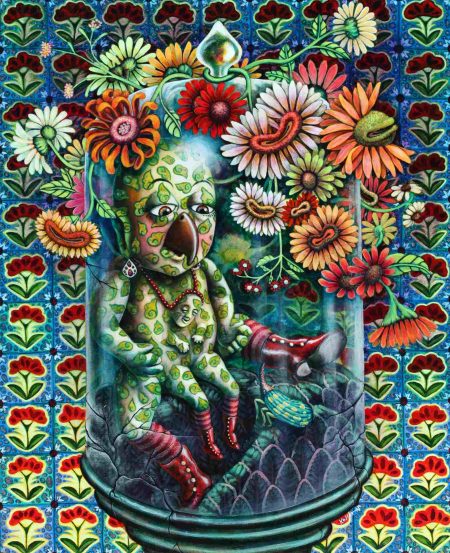
Turn 90 degrees and there’s Amy Kollar Anderson’s universe, disturbing, even menacing. Some of the paintings are part of the artist’s “Vivarium” series; its title comes from the Latin for “place of life” or “container of life,” which she manifests in closed and open transparent containers. Bell jars or lidded vessels trap strange baby dolls, as if they were specimens, in inhospitable (Anderson’s word) habitats. Outside there is an equally inhospitable environment. The artist sees the dolls “as surrogates showing the abuse or neglect of children.”2
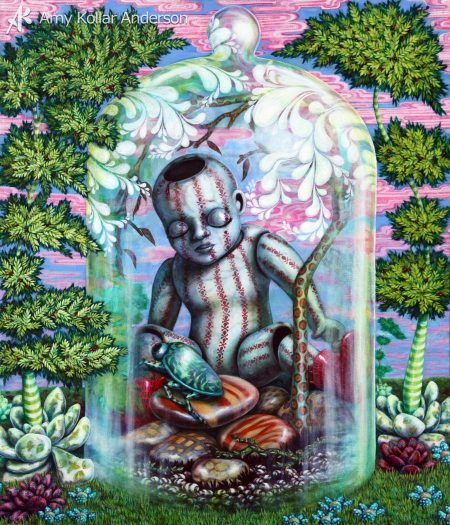
In If You Please (2009, acrylic on canvas, 18” x 22”), a beak-nosed doll, covered in tattoos of mutant cells, glances down to see a miniaturized version of herself emerge from her stomach, like the alien Badejo burst from the chest of Executive Officer Kane in Alien. Behind the jar is a tiled-wall decorated with posies and reminds me of Islamic tiles. Threatening to engulf the protective container are strange “daisies,” some with centers that might be thick lips open in frightening open-mouthed grins or stretched vulvas.
The artist’s placed carefully rendered children, modeled after young people she knows, in terrarium gardens but toxic landscapes surround them. Anderson explains, “Just because these children are currently protected, does not mean they are forever.” In these works she’s addressing her “fears about the state of the environment and the world these children will inherit.”3

The child in Contained (2007, acrylic on canvas, 34” x 24”) turns to confront the viewer with an oddly seductive look. Dressed in a sarong, her skin is mottled as if the swirling currents outside the open vessel are casting shadows on her. Amidst the maelstrom, a tree, whose roots and trunk almost cradle the child, has grown beyond the cylinder, but its leaves are dead.
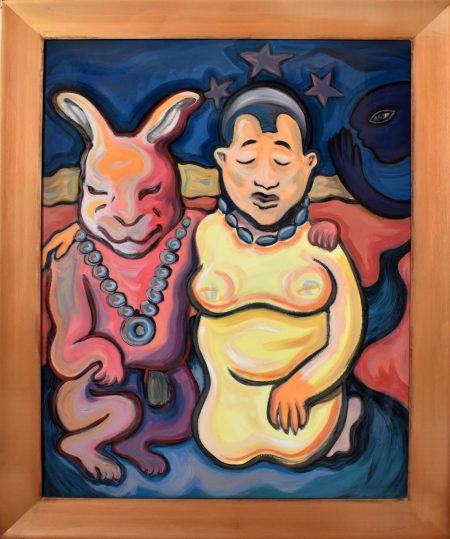
The third artist in the show is Merle Rosen, who unfortunately died on June 19, and so was unable to see this show. She had a long battle with cancer, but was active until her death. An August 12th workshop at the Lexington Fiber Guild was on her website calendar. This show serves as a memorial to her.
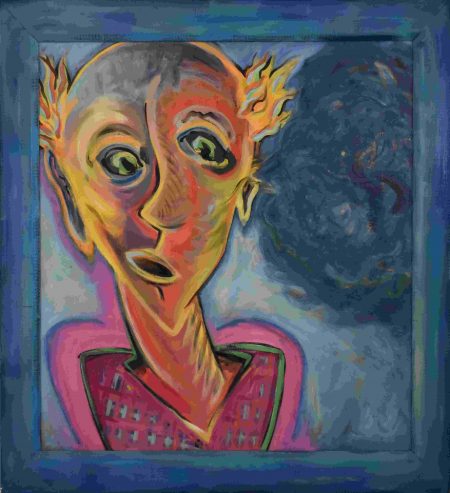
Unlike Bachman and Anderson whose visions, dreamy or nightmarish, are hyper-realistic, Rosen’s is stylized with an art brut quality, rough and raw. In Listening to the Void (date unknown, acrylic, 28” x 28”), I see a parallel with Edvard Munch’s 1893 The Scream but Rosen’s tormented figure is listening while Munch’s covers its ears as it flees a raging river and a turbulent sunset sky. With a look of incomprehension, Rosen’s doomed character is unable to escape the tornado of circular brushstrokes racing toward it.
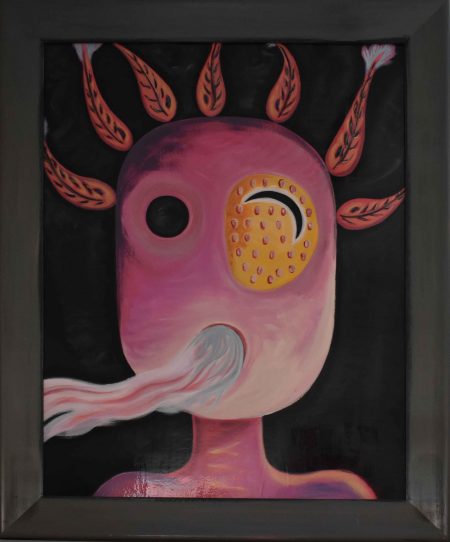
Rosen’s title Tunghat (acrylic, 46” x 36”) sent me to the Web. The Tunghat are “dwarflike Nunnehi who are masters of animals” and “known to many of the tribes of the Plains, Plateau, and Basin.” They are described as “small green people with darker hair, nails, and teeth, dressing in green and wearing rounded woven grass ponchos to hide under when necessary.”4
Rosen’s Tunghat takes an entirely different form having an oval face with a yellow potato-shaped patch over its left eye. This patch is accented by a black crescent with a halo and suggests a wink to me. Sprouting like tufts of hair from the bald skull are shapes that could be feathers, leaves, fish, or sperm. A malevolent breath spews from its mouth.
Rosen has also translated her dark vision into cast bronze sculptures. Without color their misshapen features are less terrifying. It’s interesting that for the first 15 years of her career, she produced only black-and-white drawings.
The three artists in “Other Worldly” envision very different worlds. I don’t ever want to find myself among Rosen’s mutants, even in my dreams, which would be nightmares. Anderson’s characters in their toxic and dangerous environments evoke the climate change threatening our world. Bachman’s fantastic landscapes offer hope for a more welcoming globe. Her work is a ray of light that breaks through the darkness of her companion artists’ worldviews.
Karen S. Chambers
“Other Worldly,” YWCA Women’s Art Gallery, 898 Walnut St., Cincinnati, OH 45202, 513-361-2119, fax: 513-361-2153, www:ywcacincinnati.org. Mon.-Fri., 9:00 am-5:00 pm. Through September 21, 2017
Footnotes:
1 Laine Bachman, “Artist Statement,” http://lainebachmanart.com/artist-statement.
2 Amy Kollar Anderson, “Amy Kollar Anderson Artist Statement—Vivarium Series,” gallery handout.
3 Ibid.
4 “Tunghat,” World of Darkness: Dusk, mistsofmemory.net.